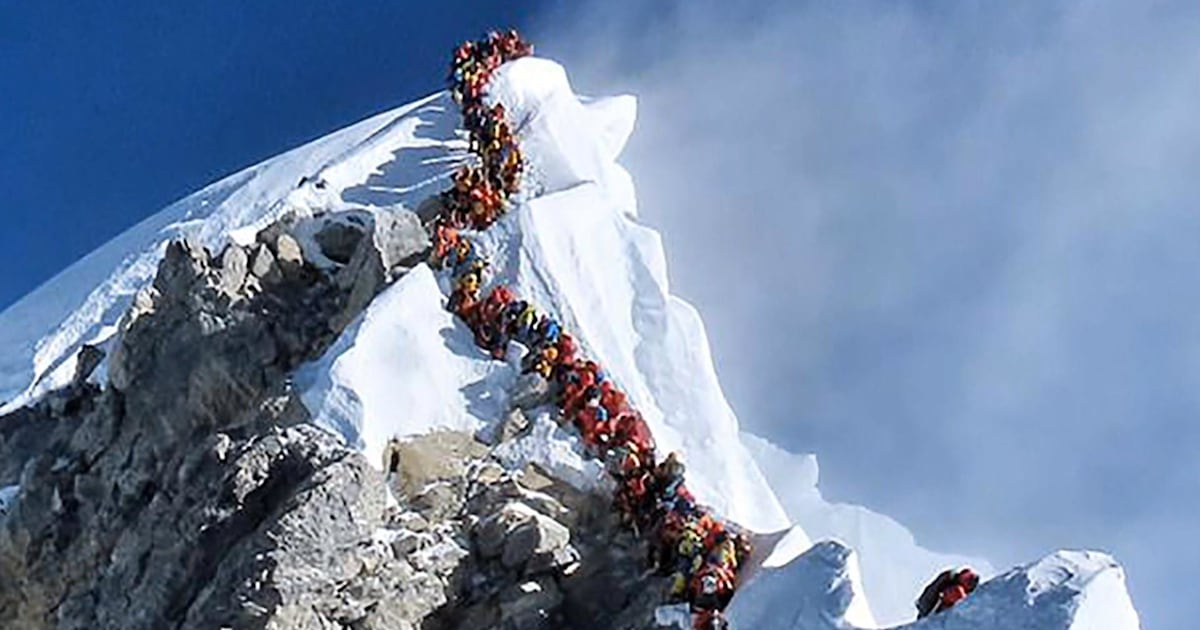Concerns Over Speed Climbing Everest: The Use Of Anesthetic Gas

Table of Contents
The Allure and Risks of Speed Climbing Everest
The allure of conquering Everest in record time is undeniable. The prestige, the bragging rights, and the sheer thrill of pushing human limits attract ambitious climbers worldwide. However, this pursuit of speed comes at a significant cost. Speed climbing Everest dramatically increases the inherent dangers already present in this challenging ascent. The reduced acclimatization time significantly increases the risk of serious health issues.
- Increased risk of high-altitude cerebral edema (HACE) and high-altitude pulmonary edema (HAPE): These life-threatening conditions are exacerbated by rapid ascents.
- Compromised judgment due to altitude and fatigue: The combination of extreme altitude and physical exhaustion can lead to poor decision-making, increasing the likelihood of accidents.
- Greater chance of accidents due to speed and reduced acclimatization time: Rushing the climb leaves less margin for error, increasing the risk of falls, slips, and other accidents.
- Environmental impact of increased traffic on Everest: The increased number of climbers attempting speed ascents adds to the already significant environmental challenges on Everest, contributing to pollution and trail degradation.
Anesthetic Gases and Their Role in Speed Climbing
Some speed climbers allegedly use supplemental oxygen mixed with other anesthetic gases to mitigate the effects of altitude sickness and push through the extreme physical demands of a rapid ascent. While the exact methods and substances remain largely undisclosed, the practice raises significant concerns.
- Temporary suppression of symptoms, not a cure for altitude sickness: These gases may temporarily mask the symptoms of altitude sickness, allowing climbers to continue their ascent, but they do not address the underlying physiological issues.
- Potential for masking serious conditions until too late: The temporary relief provided by anesthetic gases can delay the recognition of serious conditions like HACE and HAPE, leading to potentially fatal outcomes.
- Risk of addiction and dependency on the gases: The reliance on these gases to overcome the challenges of altitude can lead to physical and psychological dependence.
- Long-term health consequences from prolonged use at high altitude: The long-term effects of using anesthetic gases at extreme altitude are largely unknown and potentially harmful.
Ethical Concerns and the Debate Surrounding Anesthetic Gas Use
The use of anesthetic gases in speed climbing Everest sparks a heated ethical debate. The practice raises questions about fairness, sportsmanship, and the very nature of mountaineering.
- Is it fair to gain an advantage over other climbers who choose not to use these gases? This creates an uneven playing field, undermining the principles of fair competition.
- Does the use of these gases trivialize the inherent dangers of Everest? It could be argued that relying on such substances diminishes the respect for the mountain and the inherent challenges it presents.
- Should there be regulations or restrictions on the use of anesthetic gases on Everest? This is a crucial question that needs careful consideration by mountaineering organizations and governing bodies.
Alternative Strategies for Safe and Responsible Everest Ascents
Focusing on safety and responsible practices offers a more sustainable and ethical approach to Everest ascents.
- Gradual ascent and descent to allow for proper acclimatization: This is crucial for minimizing the risk of altitude sickness.
- Proper training and physical preparation for the climb: Adequate training and preparation significantly reduce the risk of accidents and health complications.
- Respect for the mountain and responsible waste management: Climbers have a responsibility to minimize their environmental impact.
- Prioritizing safety over speed: A safe and responsible ascent should always be prioritized over achieving a record-breaking time.
Conclusion
The use of anesthetic gases in speed climbing Everest poses serious safety and ethical concerns, raising questions about responsible mountaineering and the prioritization of speed over safety. The potential for masking serious medical conditions, the risk of addiction, and the ethical implications of gaining an unfair advantage highlight the need for a serious re-evaluation of current practices. We must reiterate the dangers of speed climbing and the potential risks associated with anesthetic gases. Let's work together to promote safer and more responsible Everest ascents. We must carefully consider the ethical implications of speed climbing Everest and the use of anesthetic gas to protect climbers and preserve the integrity of this iconic mountain. Join the conversation and let's advocate for safer Everest climbing practices – let's discuss the future of speed climbing Everest and the use of anesthetic gas responsibly.

Featured Posts
-
 The Impact Of A Judges Ruling On E Bay And Banned Chemical Listings
May 16, 2025
The Impact Of A Judges Ruling On E Bay And Banned Chemical Listings
May 16, 2025 -
 Mls Weekend Injury Report Martinez And White Unavailable
May 16, 2025
Mls Weekend Injury Report Martinez And White Unavailable
May 16, 2025 -
 Tom Cruises Post Birth Actions Regarding Suri Cruise
May 16, 2025
Tom Cruises Post Birth Actions Regarding Suri Cruise
May 16, 2025 -
 Venom Page Predicts Pimbletts Win Over Chandler A Detailed Breakdown
May 16, 2025
Venom Page Predicts Pimbletts Win Over Chandler A Detailed Breakdown
May 16, 2025 -
 Examining Bidens Recent Denials A Critical Look
May 16, 2025
Examining Bidens Recent Denials A Critical Look
May 16, 2025
